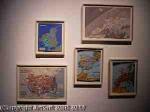Mona Hatoum
Mona Hatoum
Place: Beirut
Born: 1952
Biography:
Mona Hatoum between the years 1975 and 1981. In the years since, "she has traveled extensively and developed a dynamic art practice that explores human struggles related to political conflict, global inequity, and being an outsider."
Hatoum explores a variety of different subject matter via different theoretical frameworks . Her work can be interpreted as a description of the body, as a commentary on politics, and on gender and difference as she explores the dangers and confines of the domestic world. Her work can also be interpreted through the concept of space as her sculpture and installation work depend on the viewer to inhabit the surrounding space to complete the effect. There are always multiple readings to her work. The physical responses that Hatoum desired in order to provoke psychological and emotional responses ensures unique and individual reactions from different viewers.
Hatoum's early work consisted largely of performance pieces that used a direct physical confrontation with an audience to make a political point. She used this technique as a means of making a direct statement using her own body; the performances often referenced her background and the political situation in Palestine. In her work, she addressed the vulnerability of the individual in relation to the violence inherent in institutional power structures. Her primary point of reference was the human body, sometimes using her own body.
Created in 1988, "Measures of Distance" illustrates Hatoum's early themes of family, displacement, and female sexuality. The video piece itself is fifteen minutes long and consists of intimate, colored photographs of Hatoum's mother showering. Hatoum overlays the photographs with letters from her mother to Hatoum. The letters are handwritten in Arabic and compose the themes and the narration of the video that Hatoum is trying to convey. Hatoum's mother, living in Beirut, wrote the letters to Hatoum, living in London, and speaks of the difficulty of sending letters in a time of conflict in Lebanon. Hatoum herself reads the letters aloud in both Arabic and English. The video roots itself in the brief family reunion that occurred in Beirut between Hatoum and her parents in 1981. While primarily about the mother-daughter relationship, in her mother's letters Hatoum's father is mentioned and thus the father-daughter relationship as well as the husband-wife relationship is examined in this video.
The elements of the video—the letters, Hatoum's mother's wish to see her, and mentions of the war by Hatoum's mother—explore how the war in Palestine and the war in Lebanon displaced the identity and the relationships of Hatoum and her family. The video is neither a documentary nor meant to be journalistic. The video makes critiques about stereotypes while remaining optimistic, since the narration speaks positively in most of the letters except when speaking about the distance between the mother and daughter. Hatoum attempts to recreate the moment she had with her mother when they reunited in Beirut; the moment when Hatoum asked to photograph her in the shower. Instead of showing direct scenes about the Palestinian-Israeli Conflict or the Lebanese civil war, Hatoum shows the dire effects both wars have had on her family relationships and her identity. Displaying cultural and familial displacement, Hatoum distances and draws Western audiences closer through her English and Arabic narration.
What is especially unique about this video is how it is a portrait of a Palestinian woman. Hatoum gives her mother a voice in the video art that otherwise would not have been heard by Western audiences, Arabic and non-Arabic. The video attempts to contradict stereotypes typically made specifically about Arabic women. The Tate Modern describes the portrait in the following words: "It is through the daughter's art-making project that the mother is able to present herself freely, in a form which cements a bond of identity independent of colonial and patriarchal concerns." "Measures of Distance" is one of the few works done by Hatoum that speaks directly to her background. In other works, Hatoum prefers to be more abstract and to leave the work open ended. While not as abstract as many of her other works, the viewer is still forced to work through how to understand the formal elements of the video. They are not easily given by Hatoum like her narration is. "The video transmits the 'paradoxical state of geographical distance and emotional closeness.'"
More...
Wikipedia link: Click Here












